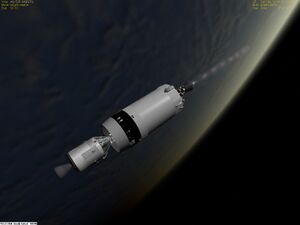Apollo to Venus Phase A scenario: Difference between revisions
imported>Mark Grant No edit summary |
imported>Mark Grant m (Revised notes.) |
||
| (2 intermediate revisions by the same user not shown) | |||
| Line 1: | Line 1: | ||
This scenario simulates Phase A of NASA's plan to send three astronauts on a manned flyby of Venus. Phase A tests the use of the SIVB as a 'wet workshop' and the 'eyes-out' burn with the CSM docked to the SIVB. | |||
==Procedure== | |||
[[Image:Apollo-eyeballs-out.jpg|thumb|right|A different kind of SIVB burn]] | [[Image:Apollo-eyeballs-out.jpg|thumb|right|A different kind of SIVB burn]] | ||
Launch into orbit as normal. Seperate from the SIVB, then rotate and dock with the tunnel on the front, which would, in a real mission, allow the astronauts to enter the SIVB after the fuel tanks have vented. Use the AGC TLI program (Prog 15) to program a burn which will put you into an orbit with a period of around 20 days. | Launch into orbit as normal. Seperate from the SIVB, then rotate and dock with the tunnel on the front, which would, in a real mission, allow the astronauts to enter the SIVB after the fuel tanks have vented. Use the AGC TLI program (Prog 15) to program a burn which will put you into an orbit with a period of around 20 days. | ||
| Line 13: | Line 15: | ||
While docked, the CSM can draw power from batteries in the SIVB as well as its fuel cells. Run Prog 59 again and enter +00002 in R1 to run the power display program. This displays the power flow from the SIVB to the CSM, and the power left in the SIVB batteries. After the 'TLI' burn you should be able to shut down two fuel cells to conserve fuel. | While docked, the CSM can draw power from batteries in the SIVB as well as its fuel cells. Run Prog 59 again and enter +00002 in R1 to run the power display program. This displays the power flow from the SIVB to the CSM, and the power left in the SIVB batteries. After the 'TLI' burn you should be able to shut down two fuel cells to conserve fuel. | ||
Finally, as you approach the Earth at the end of your orbit, seperate from the SIVB, use the SPS to do a course-correction to put the CM into a suitable re-entry position, then seperate from the SM and re-enter as normal. | Finally, as you approach the Earth at the end of your orbit, seperate from the SIVB, use the SPS to do a course-correction to put the CM into a suitable re-entry position, then seperate from the SM and re-enter as normal. | ||
==Notes== | |||
* You can only use the [[C AGC | C++ AGC]] with this scenario, not the [[Virtual AGC]]. | |||
* I've never flown the full scenario, so let me know if it works :). | |||
[[Category:Fictional Scenarios]] | [[Category:Fictional Scenarios]] | ||
Latest revision as of 21:54, 16 November 2006
This scenario simulates Phase A of NASA's plan to send three astronauts on a manned flyby of Venus. Phase A tests the use of the SIVB as a 'wet workshop' and the 'eyes-out' burn with the CSM docked to the SIVB.
Procedure

Launch into orbit as normal. Seperate from the SIVB, then rotate and dock with the tunnel on the front, which would, in a real mission, allow the astronauts to enter the SIVB after the fuel tanks have vented. Use the AGC TLI program (Prog 15) to program a burn which will put you into an orbit with a period of around 20 days.
The program will run and fire the engine. Due to limitations of Orbiter's guidance control with docked spacecraft you may need to put the SIVB into prograde orientation manually before the burn, by switching focus to the SIVB, rotating until you're close to the correct orientation and then letting the Orbiter autopilot finish the job.
After the SIVB shuts down, you need to vent the fuel. Run the fictional Prog 59 to do this: it's a generic 'docked vessel control' program.
R1 shows the specific subprogram to run. Enter +00001 then press PRO to start and stop the fuel venting... the AGC will display the amount of fuel left in the SIVB as it's vented. By the end of the venting process you should be in an orbit with about a 28 day period.
While docked, the CSM can draw power from batteries in the SIVB as well as its fuel cells. Run Prog 59 again and enter +00002 in R1 to run the power display program. This displays the power flow from the SIVB to the CSM, and the power left in the SIVB batteries. After the 'TLI' burn you should be able to shut down two fuel cells to conserve fuel.
Finally, as you approach the Earth at the end of your orbit, seperate from the SIVB, use the SPS to do a course-correction to put the CM into a suitable re-entry position, then seperate from the SM and re-enter as normal.
Notes
- You can only use the C++ AGC with this scenario, not the Virtual AGC.
- I've never flown the full scenario, so let me know if it works :).